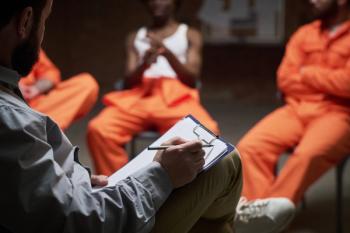
- Psychiatric Times Vol 25 No 13
- Volume 25
- Issue 13
Dignity in the Gray Zone Indiana v Edwards
The jaw-dropping indignity was easy to miss at a time when the O.J. Simpson murder trial was unfolding. A man named Colin Ferguson had been charged with killing 6 people and wounding another 19 after an apparently indiscriminant shooting spree aboard a Long Island railroad train.
"The dignity at issue is the supreme dignity of being master of one’s fate rather than a ward of the State-the dignity of individual choice."
US Supreme Court Justice Antonin Scalia,
Indiana v Edwards, USSC, 20081
"It matters not how strait the gate,
How charged with punishments the scroll,
I am the master of my fate: I am the captain of my soul."
William Ernest Henley, Invictus
The jaw-dropping indignity was easy to miss at a time when the O.J. Simpson murder trial was unfolding. A man named Colin Ferguson had been charged with killing 6 people and wounding another 19 after an apparently indiscriminant shooting spree aboard a Long Island railroad train. Ferguson’s trial somehow turned into a disgraceful demonstration of justice gone awry.
Insofar as justice refers to fairness, conformity to truth, and reason, the Ferguson trial appeared to be the antithesis. Ferguson was allowed to represent himself, despite a serious mental illness that any layperson would be able to recognize. As soon as Ferguson began to make his arguments, it was as if all dignity, fairness, and reason had fled the courtroom. Many times, the trial became both offensive and bizarre, as Ferguson demonstrated prominent irrational, delusional thinking, and “cross-examined” the victims he had shot.2 The debacle was broadcast live by both local media and court television.
Competence to stand trial
Competency to stand trial (CTST) is but one specific type of competency. In 1960, the US Supreme Court articulated the modern American standard for CTST in Dusky v United States.3 That standard is whether a criminal defendant “has sufficient ability to consult with his lawyer with a reasonable degree of rational understanding, and whether he has a rational as well as factual understanding of the proceedings against him.” At both the federal and state levels, the Dusky language has been adopted as the “test” for CTST.
In essence, the Dusky standard requires that the defendant:
• Understand the proceedings against him or her.
• Be able to assist counsel in his own defense.
Impairment in either of these elements may result in a finding of incompetency to stand trial (ICTST).
The defense attorney, the judge, or the prosecutor, at any point, may raise the issue of a defendant’s CTST during the criminal proceedings. In practice, it is the defense attorney who most often raises the issue. A defendant’s competency is often questioned when the defendant is obviously mentally ill, has a history of mental illness, or has demonstrated difficulty interacting with the court or defense counsel. In a review of 8416 patients referred for CTST examinations, evaluators found 19% of defendants to be incompetent to stand trial.4 Psychotic and “organic/intellectual” disorders were most strongly associated with findings of incompetence.
Table 1 lists some other common reasons why a defendant may be found incompetent to stand trial.
A defendant may exhibit symptoms of a major mental illness, yet still remain competent to stand trial as long as the symptoms do not impair the specific areas of functioning required for competence. The necessity of the defendant being competent to stand trial is guaranteed by the US Constitution, including the Sixth Amendment (right to confront witnesses, right to counsel) and the Fourteenth Amendment (right to substantive and procedural due process of law). Other reasons for requiring a defendant to be competent to stand trial include preserving the dignity of the defendant, as well as the dignity, fairness, and accuracy of the criminal justice system.
Indiana v Edwards
In its 2008 ruling in Indiana v Edwards, the US Supreme Court considered the case of a defendant with mental illness who was in the “gray area” of being able to satisfy the Dusky standard, yet who “may be unable to carry out the basic tasks needed to present his own defense without the help of counsel [page 10].”1 Ahmad Edwards had attempted to steal a pair of shoes and, in the process, he fired a gun at a security guard and wounded a bystander. He was charged with attempted murder, battery with a deadly weapon, criminal recklessness, and theft. Before Edwards ever went to trial on these charges, he had been found incompetent to stand trial twice and had made 2 requests to represent himself. Both requests were denied.
Edwards was ultimately convicted, at 2 different hearings, on all the previously mentioned charges. Edwards then appealed his convictions, arguing that he was deprived of his constitutional right (via the Sixth and Fourteenth Amendments) to represent himself at trial. The appellate court agreed, and the matter went to the Indiana Supreme Court who affirmed. The US Supreme Court agreed to consider Edwards’s case because the precise question presented had never been posed to them.
The American Psychiatric Association and the American Academy of Psychiatry and the Law (AAPL) submitted an amicus curiae (friend of the court brief) brief pointing out how disorganized thinking and other symptoms of serious mental illness can impair a defendant’s ability to “play the significantly expanded role required for self-representation even if he can play the lesser role of represented defendant.”5
The Supreme Court reasoned that “the nature of the problem” cautioned against using a single standard for both competence to proceed to trial with representation and competence to represent oneself.
Even though a defendant may satisfy the Dusky competence standard, this standard did not address the ability to represent oneself, which required important tasks-such as organizing one’s defense, making motions, arguing points of law, participating in voir dire (preliminary examination of jurors and/or witnesses), questioning witnesses, and addressing the court and jury. In a pronouncement that seemed tailor-made for Ferguson, the Court stated that “a self-representation right at trial will not ‘affirm the dignity’ of a defendant who lacks the mental capacity to conduct his defense without the assistance of counsel . . . and may undercut the most basic of the Constitution’s criminal law objectives, providing a fair trial [page 2].”
The Supreme Court still had the task of distinguishing the issue addressed in Edwards from a previous case, Godinez v Moran,6 in which the Court held that competence to plead guilty or to waive counsel did not require a higher or more elaborate standard than Dusky. The Court reasoned that Godinez and Edwards both “involve a mental condition that falls in a gray area between Dusky’s minimal constitutional requirement that measures a defendant’s ability to stand trial and a somewhat higher standard that measures mental fitness for another legal purpose [page 7].” However, in Godinez, the defendant’s ability to represent himself at trial was not at issue. Rather, Godinez specifically dealt with the competence required to waive one’s right to counsel and not the competence to represent oneself. Table 2 lists 2 of the landmark cases and issues considered by the Supreme Court in Edwards.
Thus, in Godinez, the “higher standard” was specifically the ability to proceed on one’s own to enter a guilty plea. In contrast, the higher standard in Edwards sought to measure a defendant’s ability to conduct trial proceedings. The holding in Godinez did not tell a state “whether it may deny a gray-area defendant the right to rep-resent himself [page 8].” In other words, if the defendant has a mental illness, yet meets the Dusky standard and wants to represent himself, is it constitutional for a state to limit his right to self-representation by insisting on representation by counsel at trial “on the ground that [he] lacks the mental capacity to conduct his trial defense unless represented [page 8].” The Supreme Court’s answer to this question was yes.
The Court’s holding, by a 7 to 2 majority, was that “the Constitution does not forbid States from insisting upon representation by counsel for those competent enough to stand trial but who suffer from severe mental illness to the point where they are not competent to conduct trial proceedings by themselves.” Justices Scalia and Thomas were the dissenters, arguing that the case was not about whether there were limits to a defendant’s right to self-representation, but “whether a State’s view of fairness . . . permits it to strip the defendant of this right [page 6].” The dissent focused primarily on the “inestimable worth of free choice” and the “dignity and autonomy of the accused [pages 8, 9]” yet seemed to miss the all-important nuances of how severe mental illness is capable of degrading the very autonomy it so highly esteems. And herein lies the thorniest part of the entire issue: what is the greater “dignity”? Is it avoiding a humiliating spectacle and preserving the fair, rational proceedings of the court? Or is it, as the dissent appeared to imply, honoring the defendant’s “right to challenge the State’s case against him using the arguments he sees fit [page 5]”?
Ultimately, the dissent believed that the “dignity” at issue was the “supreme human dignity” of being master of one’s fate and maintaining individual choice. If this means making a fool of oneself and/or conducting a defense to one’s disadvantage, then so be it-“don’t tread on me.” In effect, the dissent swept aside critical particulars of how mental illness in the gray zone might affect the complex mental abilities required to represent oneself with its rigid (and perhaps illusory) view of an ideal state of pure autonomy. This is unfortunate because much is lost in the glossing over of how a defendant in the gray zone might lack the ability to prepare and organize his defense, prepare a line of questioning for witnesses, make appropriate objections, etc. Will allowing a defendant with mental illness to represent himself result in a display of supreme dignity?
Obviously, there remain some very divergent notions about the nature of mental illness in the Supreme Court. For example, the majority stated that “mental illness itself is not a unitary concept. It varies in degree. It can vary over time. It interferes with an individual’s functioning at different times in different ways [page 10].” Bravo. On the other hand, the dissent appeared to use recent efforts to de-stigmatize mental illness as an opportunity to argue against the notion that mental illness may impair the as yet, ill-defined higher standard of representing oneself: “In singling out mentally ill defendants for this treatment, the Court’s opinion does not even have the questionable virtue of being politically correct. At a time when all society is trying to mainstream the mentally impaired, the Court permits them to be deprived of a basic constitutional right-for their own good [page 11].”
To the dissent’s credit, it is hard to dismiss their assertion that the majority’s holding was “extraordinarily vague.” The Court rejected Indiana’s invitation to craft a test for the higher competency standard to represent oneself, and the dissent predicted that the Court will ultimately have to “give some meaning to this holding in the future, but the indeterminacy makes a bad holding worse [page 11].” Nevertheless, the Court refrained out of uncertainty about “how that particular standard would work in practice [page 13].” For the time being, the Court left trial judges with substantial latitude, concluding that “the trial judge . . . will often prove best able to make more fine-tuned mental capacity decisions, tailored to the individualized circumstances of a particular defendant [page 12].”
This holding will prove rather interesting, if not confusing, for both courts and forensic mental health professionals. Much progress has been made in forensic mental health in evaluating CTST. Many instruments have been developed to assist forensic mental health professionals in evaluating CTST.7-10 In 2007, AAPL published its comprehensive Practice Guideline for the Forensic Psychiatric Evaluation of Competence to Stand Trial.11 Yet the research on pro se (self-representational) capacities is scant to nonexistent. A recent study of felony defendants who represented themselves concluded that they made up less than 1% of all felony defendants. It turned out that pro se defendants in state court did just as well as felony defendants with representation, and only 20% of pro se felony defendants displayed signs of mental illness.12
In effect, the Court has told judges and forensic experts to venture forth onto foggy and uncharted seas. At the very least, new research in this area should prove fascinating. How will one make the fine distinction between a defendant’s lack of competence to represent himself (given all the complex tasks involved) and his mere bad judgment? Will we be able to distinguish a mentally ill defendant’s decision to put forth a poorly conceived or disadvantageous defense from an illogical defense that flows from his mental illness? Will more serious charges require a higher level of competence for the defendant who represents himself pro se?13
The questions, at this point, seem both complex and endless-but such is the terrain that must be traveled in the pursuit of justice and dignity. In fact, the meaning of “dignity” itself is often very unclear. Dignity is a phenomenon of human perception and, as such, is a relative and subjective concept. Everyday life demands that each of us “voluntarily and repeatedly” relinquish dignity for certain compelling reasons.14 Perhaps the differing views of the US Supreme Court on dignity in the gray zone underscore this relativity.
References:
References
1. Indiana v Edwards, 554 USSC (2008) (Scalia J, dissenting, 8).
2. Bardwell MC, Arrigo BA. Criminal Competency on Trial: The Case of Colin Ferguson. Durham, NC: Carolina Academic Press; 2002.
3. Dusky v United States, 362 US 402 (1960).
4. Warren JI, Murrie DC, Stejskal W, et al. Opinion formation in evaluating the adjudicative competence and restorability of criminal defendants: a review of 8,000 evaluations. Beh Sci Law. 2006;24:113-132.
5. Taranto RG. Brief for the American Psychiatric Association and American Academy of Psychiatry and the Law as amici curiae in support of neither party. Published February 11, 2008.
http://www.abanet.org/publiced/preview/briefs/pdfs/07-08/07-208_NeutralAmCuAPAAAPL.pdf
. Accessed October 6, 2008.
6. Godinez v Moran, 509 US 389 (1993).
7. Rogers R, Tillbrook CE, Sewell KW. ECST-R. Evaluation of Competency to Stand Trial-Revised. Lutz, FL: Psychological Assessment Resources, Inc; 2004.
8. McGarry A, Curran W. Competency to Stand Trial and Mental Illness. Rockville, MD: National Institute of Mental Health; 1973.
9. Johnson W, Mullet N. Georgia Court Competency Test-R. In: Hersen M, Bellack A, eds. Dictionary of
Behavioral Assessment Techniques. New York: Pergamon Press; 1987.
10. Hoge S, Bonnie RJ, Poythress N, Monahan J. The MacArthur Competence Assessment Tool-Criminal Adjudication. Odessa, FL: Psychological Assessment Resources; 1999.
11. Mossman D, Noffsinger SG, Ash P, et al. AAPL practice guideline for the forensic psychiatric evaluation of competence to stand trial. J Am Acad Psychiatry Law. 2007;35(suppl 4):S3-S72.
12. Hashimoto E. Defending the right to self representation: an empirical look at the pro se felony defendant. North Carolina Law Review. 2007;85:423-
487.
13. Buchanan A. Competency to stand trial and the seriousness of the charge. J Am Acad Psych Law. 2006;34:458-465.
14. Pinker S. The stupidity of dignity. New Republic. May 28, 2008.
http://www.tnr.com/story_print.html? id=d8731cf4-e87b-4d88-b7e7-f5059cd0bfbd
. Accessed on September 15, 2008.
Articles in this issue
about 17 years ago
Two Stories We Tell Ourselves About Cancerabout 17 years ago
An Epidemic of Depressionabout 17 years ago
Drug Makers to Report Physician Paymentsabout 17 years ago
The Facts About Violence Against Historically Disadvantaged Personsabout 17 years ago
Vets Suicide Hotline on the Hot Seatabout 17 years ago
New Link Found Between Brain Protein and Alzheimer Diseaseabout 17 years ago
Nations Convene to Create Bipolar Consensus StatementNewsletter
Receive trusted psychiatric news, expert analysis, and clinical insights — subscribe today to support your practice and your patients.














